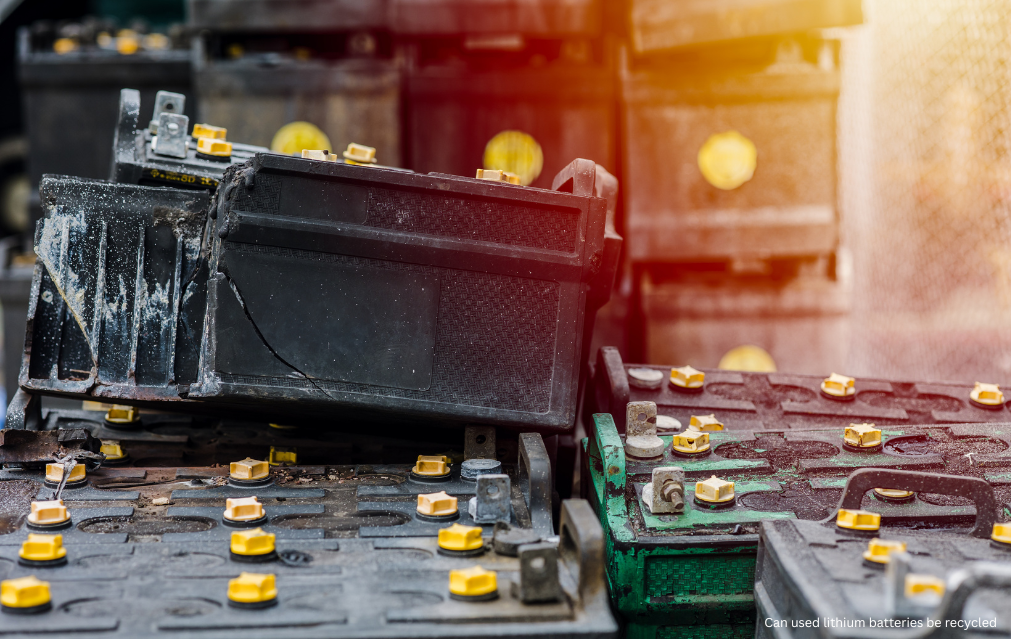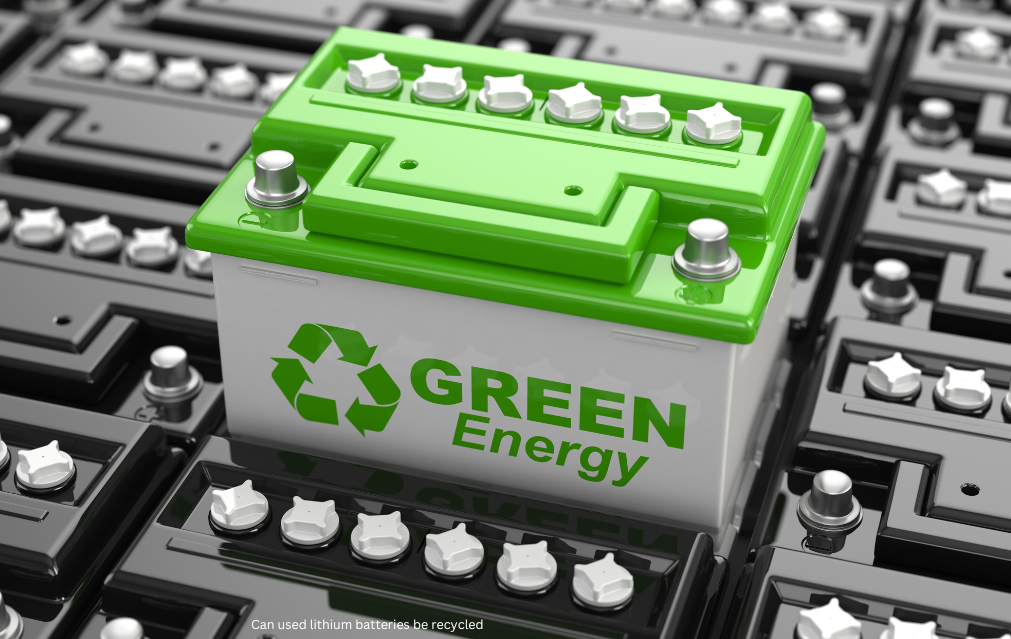Imagine tossing your old phone battery in the trash, thinking it’s harmless. But did you know lithium batteries can leak toxic chemicals, spark fires, and harm the environment? Every year, millions of used lithium batteries end up in landfills, creating serious pollution and safety risks.
Many people don’t know what to do with their dead batteries. Should you throw them away? Can they be reused? Do lithium batteries even need recycling? The confusion leads to improper disposal, which only adds to the problem.
This post will clear up the mystery. You’ll learn why lithium battery recycling is essential, how the process works, and the best way to dispose of your used batteries safely. By the end, you’ll know exactly what to do to help protect the environment and even contribute to a more sustainable future.
So, can used lithium batteries be recycled? Let’s find out.

Why Should Lithium Batteries Be Recycled?
Every year, millions of lithium batteries are thrown away. Some end up in landfills. Others are burned or buried. This is dangerous for people and the planet. Recycling these batteries is not just a choice—it is a necessity.
Protecting the Environment
When lithium batteries break down, they release harmful chemicals. These chemicals can seep into the soil and water. This pollution affects plants, animals, and even drinking water. Burning batteries is worse. It releases toxic fumes that pollute the air. Recycling stops this damage. It keeps harmful materials out of nature and reduces pollution.
Saving Valuable Resources
Lithium, cobalt, and nickel are not unlimited. They come from the earth, and mining them causes environmental damage. Extracting these metals also takes a lot of energy. Recycling helps recover these materials from old batteries. This reduces the need for mining and saves natural resources for the future.
Preventing Fires and Toxic Leaks
Old lithium batteries are not harmless. If they are damaged, they can leak dangerous chemicals. Some even explode when exposed to heat. This makes them a fire hazard in landfills and garbage trucks. Proper recycling prevents these risks. It ensures that batteries are handled safely.
Following the Law
Many countries have strict rules for battery disposal. The United States, the European Union, and China all have recycling programs. Some places even fine people for throwing batteries in the trash. Companies that make lithium batteries must also follow recycling regulations. These laws help reduce waste and protect the environment.
Recycling lithium batteries is not just about following rules. It’s about making smart choices. It helps the planet, saves resources, and keeps people safe. The next time you replace a battery, think before you toss it away.
Is Lithium Reusable?
Lithium is a key ingredient in modern batteries. It powers smartphones, laptops, and electric cars. But what happens when the battery dies? Can the lithium inside be used again? The answer is yes—but it’s not that simple.
Extracting Lithium from Old Batteries
Lithium does not disappear when a battery stops working. It can be removed and reused in new batteries. Scientists use special methods to extract lithium from old battery cells. The process involves crushing the battery, dissolving the materials, and separating the lithium. Once purified, it can be used again to make fresh batteries.
The Challenges of Lithium Recovery
Recycling lithium is not easy. The extraction process is expensive and complex. Unlike lead-acid batteries, which have a high recycling rate, lithium batteries are harder to break down. Some lithium is lost during the process. Contamination from other metals also makes recovery difficult. Because of this, many old lithium batteries still end up in landfills.
New Technology is Changing the Game
Researchers are finding better ways to reuse lithium. New recycling methods recover more lithium with less waste. Some companies are developing closed-loop systems. These allow lithium to be reused multiple times without losing quality. Solid-state battery technology may also help. These batteries last longer and are easier to recycle.
Lithium is reusable, but the process needs improvement. As technology advances, recycling will become cheaper and more efficient. This will reduce waste and help the world rely less on newly mined lithium.
How Are Lithium Batteries Recycled?
Recycling lithium batteries is not as simple as tossing them into a bin. The process involves several steps to recover valuable materials safely. Let’s break it down step by step.
1. Collection & Sorting
First, used batteries are collected from recycling centers, electronics stores, and special drop-off points. They are sorted by type, size, and chemistry. This is important because different batteries require different recycling methods.
2. Discharging & Dismantling
Before recycling, batteries must be discharged to remove any leftover energy. This prevents fires and explosions. After discharging, they are taken apart. The outer casing is removed, and the internal components are separated.
3. Material Separation & Extraction
Once dismantled, the valuable materials inside the battery—lithium, cobalt, nickel, and copper—must be extracted. There are two main methods for this:
- Pyrometallurgical Recycling: Batteries are melted at high temperatures to recover metals. This method is effective but uses a lot of energy.
- Hydrometallurgical Recycling: Chemicals dissolve the battery materials, making it easier to extract lithium and other metals. This method is more efficient and eco-friendly.
- Direct Recycling: Some companies are testing ways to reuse battery materials without breaking them down completely. This could make recycling faster and cheaper.
4. Refining & Reuse
After extraction, the recovered materials are purified and sent to battery manufacturers. These refined metals are used to make new lithium batteries, reducing the need for fresh mining.
Who is Leading the Way?
Companies like Redwood Materials, Li-Cycle, and Umicore are developing better recycling methods. Research projects worldwide are working on ways to increase efficiency and reduce costs. Innovations in battery design are also making recycling easier.
Recycling lithium batteries is essential for reducing waste and conserving resources. As technology improves, the process will become even more effective, making lithium battery recycling a key part of a sustainable future.
How Should Lithium Batteries Be Disposed of Properly?
Throwing lithium batteries in the trash might seem easy, but it is dangerous. These batteries can leak toxic chemicals, cause fires, or even explode. Many people do not realize the risks. So, what is the right way to dispose of them?
What Not to Do
- Do not throw them in household trash – They can catch fire in garbage trucks or landfills.
- Do not burn them – This releases harmful gases into the air.
- Do not store damaged batteries carelessly – A punctured or swollen battery can leak or explode.
The Right Way to Dispose of Lithium Batteries
- Check Local Recycling Programs
Many cities have special programs for battery recycling. Some electronics stores also accept old batteries for safe disposal. - Store Used Batteries Safely
Keep old batteries in a non-metallic container, like a plastic box. Avoid placing them near heat, water, or flammable materials. - Take Them to a Certified Recycling Center
Find a government-approved e-waste recycling center. These facilities follow strict safety measures to handle lithium batteries properly. - Follow Manufacturer and Government Guidelines
Some battery makers provide specific disposal instructions. Local governments also have rules for safe recycling. Checking these guidelines ensures responsible disposal.
Proper disposal of lithium batteries protects the environment and prevents dangerous accidents. The next time you replace a battery, remember to recycle it the right way.

The Future of Lithium Battery Recycling
Recycling lithium batteries is improving every year. Scientists and companies are working on better ways to recover materials and reduce waste. The future of battery recycling looks promising, with new technologies and smarter solutions leading the way.
Closed-Loop Recycling Systems
A closed-loop system allows old batteries to be turned into new ones. Instead of throwing away used materials, they are collected, processed, and reused. This system reduces the need for mining and lowers environmental damage. Companies like Redwood Materials and Li-Cycle are already making this a reality.
Solid-State Batteries: A Greener Choice
Solid-state batteries are a new type of battery that could replace lithium-ion batteries in the future. They last longer, charge faster, and are safer. Since they use fewer toxic materials, they are also easier to recycle. As technology improves, solid-state batteries may become the standard.
How Everyone Can Help
Recycling batteries is not just for big companies. Businesses and consumers play an important role too. Companies can design batteries that are easier to recycle. People can return used batteries to recycling centers instead of throwing them away. Schools, offices, and communities can also spread awareness about proper battery disposal.
The future of lithium battery recycling is about creating a world where nothing goes to waste. With better technology and smarter choices, we can make batteries more sustainable for generations to come.
Conclusion: The Responsibility of Recycling Lithium Batteries
Recycling lithium batteries is not just an option—it is a responsibility. These batteries contain valuable materials that can be reused. If thrown away carelessly, they can pollute the environment and cause safety hazards. Proper recycling helps protect nature, conserve resources, and reduce the need for mining.
Everyone has a role to play. Consumers should take their used batteries to certified recycling centers instead of throwing them in the trash. Businesses can invest in better recycling systems and design batteries that are easier to reuse. Governments must continue to enforce strict recycling regulations to ensure a cleaner future.
Making small changes can have a big impact. Start by checking local recycling programs and educating others about the importance of responsible e-waste disposal. Together, we can create a sustainable system where lithium batteries are recycled efficiently and safely.
